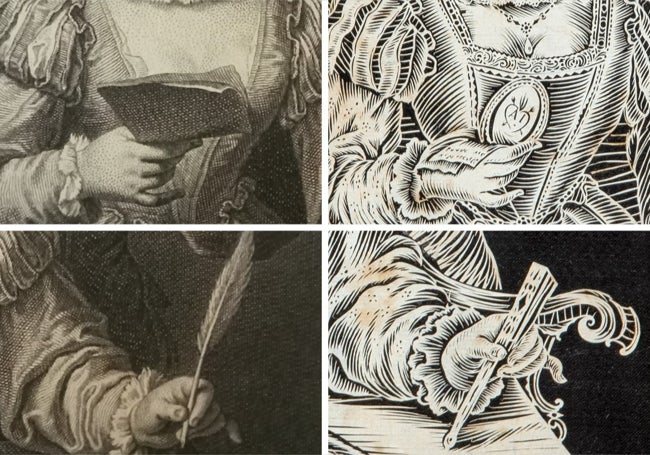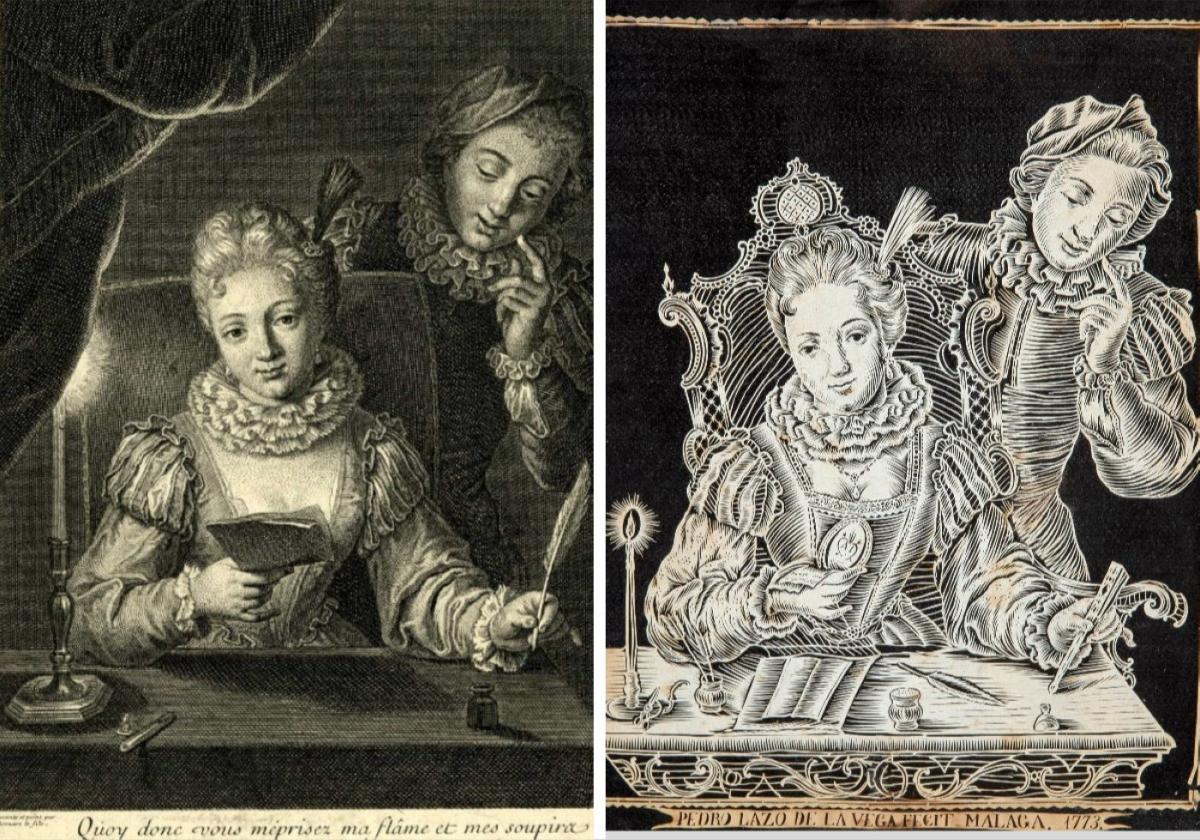18th-century Malaga work purchased by Spain's ministry of culture was based on a British Museum print
Artist Pedro Lazo de la Vega was commissioned to do the work, based on a print by Robert-François Bonnart, by English writer Richard Twiss
Francisco Griñan
Malaga
Friday, 14 February 2025, 12:49
There are few works of art like this in the market. And even fewer with the signature of one of its great masters, Pedro Lazo de la Vega. A more than justified reason for Spain's ministry of culture to acquire one of his works dated in Malaga in 1773.
The image depicts a court scene, featuring a couple, and its uniqueness comes from the strange technique used, the 'grafidia'. This technique consists of a cut paper drawing and was a highly appreciated format in the eighteenth century, particularly among the royal houses and the European upper classes. In addition to the rarity of the technique, the origin and the protagonists of the portrait were undisclosed. This mystery has now been resolved with the revelation that this scissors picture is based on a French print pertaining to the British Museum.

The origin of the work was discovered by the collector Óscar Jaume Peña Ginés. After reading in SUR about the acquisition of Lazo de la Vega's grafidia, he has disclosed that the piece is in fact a copy. He says that variations of the print Scène Galante, were completed in the early 18th century and printed in Paris by François de Poilly The Younger (1666-1741), one of the great masters of this technique at the time.
"It represents a Renaissance scene, in which a young woman sits at a candlelit desk. On the table is an inkwell, and she holds a letter in one hand and a pen in the other while being observed by a young man in the background," explains the expert. Peña Ginés knows the piece very well since, like the British Museum, he possesses an etching of the image in his own collection. His is one of the most important private collections in Spain with more than five hundred prints from the early sixteenth century up to the twentieth century.
The painter Robert-François Bonnart (1683-1771) was the creator of the original drawing, which was converted into a graphic work by Poilly The Younger, as can be read at the bottom of the copies kept by both the British Museum and the Peña Ginés Collection.
The portrait is estimated to have been painted between 1693 and 1741, and acquired by the London gallery in 1873. It depicts a suitor standing behind a young woman who is writing a letter and occupies the centre of the composition. The print also includes some verses in French at the bottom that reveal that this Scène Galante is of a man unhappy with the game played by the lady, Iris.
The verse reads "Why then do you despise my flame and my sighs / While you fulfil the desires of a rival / Is that the loyalty you swore to me / Iris, enough, let us go no further; / A husband like a lover / Would be an object of mockery."
Not an exact copy
It is most likely that a copy of this print or a reproduction of it came into the hands of Pedro Lazo de la Vega, when he lived in Malaga.
Vega received a visit from the English traveller, writer and Hispanist Richard Twiss (1747-1821), who commissioned him to make a grafidia. The model chosen by the artist or, perhaps, by the buyer himself was Bonnart's Scène Galante. However, the Spaniard's piece cannot be considered an exact copy since the Andalusian artist - believed to have been born in Seville - added his own variations on the theme and characters.
As can be seen in the comparison of both images, the similarity of the faces and costumes of the characters is evident. However, the cropped drawing eliminates the curtain on the left, reduces the height of the candle that illuminates the protagonists and decorates the armchair more profusely with sculpted wood details. Vega also changes the position of the letter and the pen so that the young woman appears with new objects. These include a cameo with the letters 'A' and 'I' inside a heart, in her right hand, and a closed fan in her left. The woman also wears a striking necklace with a tear-shaped pearl that does not appear in the original print. The reasons for the changes and the symbolism of these new features are unknown, although the 'I' coincides with the initials of Iris, the character in the original poem.
Finally, the verses in French are replaced in the grafidia by the phrase "Pedro Lazo de la Vega fecit Málaga. 1773" (Made by Pedro Lazo de la Vega in Malaga. 1773), which reveals the origin of this rare work. The Ministry of Culture, who acquired the piece for 13,000 euros, has revealed that its new home will be the Museum of Decorative Arts (MNAD), which possesses less than a dozen grafidias in its collection.
According to experts, the discovery of the connection between the print and Vega's scissor-cut paper drawing not only clarifies its origin, but also adds value to this piece. Vega's work is unique and is a striking departure from the original.
